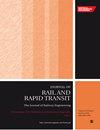Rail machining – current practices and potential for optimisation
IF 1.7
4区 工程技术
Q3 ENGINEERING, CIVIL
Proceedings of the Institution of Mechanical Engineers Part F-Journal of Rail and Rapid Transit
Pub Date : 2023-07-11
DOI:10.1177/09544097231187978
引用次数: 0
Abstract
Current practices on rail machining show large variations in strategies and amount of grinding and milling. To identify reasons for this and suggest strategies to further optimise rail machining, objectives of machining are scrutinised and consequences of not fulfilling objectives are investigated. This leads to a discussion on potentially detrimental effects of rail machining and how to minimise these. With this background, general aspects of rail machining optimisation are discussed. The study shows several means to improve rail machining, but also how the potential is restricted by the current lack of knowledge and predictive models. This prevents quantifying benefits of innovative solutions, and complicates transfer of knowledge between different operational conditions and translations of (scaled and controlled) test results to (full-scale, uncontrolled) operational conditions.钢轨加工-当前实践和优化潜力
目前的钢轨加工实践表明,在磨削和铣削的策略和数量上有很大的变化。为了确定原因并提出进一步优化钢轨加工的策略,对加工目标进行了仔细检查,并对未实现目标的后果进行了调查。这导致了对钢轨加工的潜在有害影响以及如何将其最小化的讨论。在此背景下,讨论了钢轨加工优化的一般方面。该研究显示了改善钢轨加工的几种方法,但也显示了目前缺乏知识和预测模型的潜力如何受到限制。这阻碍了对创新解决方案的效益进行量化,并使知识在不同操作条件之间的转移和(按比例和受控的)测试结果到(全面的,不受控制的)操作条件的转换变得复杂。
本文章由计算机程序翻译,如有差异,请以英文原文为准。
求助全文
约1分钟内获得全文
求助全文
来源期刊

CiteScore
4.80
自引率
10.00%
发文量
91
审稿时长
7 months
期刊介绍:
The Journal of Rail and Rapid Transit is devoted to engineering in its widest interpretation applicable to rail and rapid transit. The Journal aims to promote sharing of technical knowledge, ideas and experience between engineers and researchers working in the railway field.
 求助内容:
求助内容: 应助结果提醒方式:
应助结果提醒方式:


